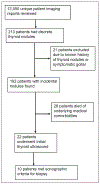Incidental Thyroid Nodules Found During Acute Stroke Angiography: Prevalence, Outcomes, and Suggested Management Guidelines
- PMID: 34458891
- PMCID: PMC8389737
- DOI: 10.1177/87564793211018459
Incidental Thyroid Nodules Found During Acute Stroke Angiography: Prevalence, Outcomes, and Suggested Management Guidelines
Abstract
Objective: In stroke patients, extensive interventions for incidental thyroid nodules can be burdensome and costly. It appears that the risk of malignancy has not been reported in angiographically detected nodules and outcomes have not yet been described in patients, receiving acute stroke work-up.
Materials and methods: Incidental thyroid nodules were found on neck computerized tomography angiography or magnetic resonance angiography performed during inpatient stroke workup (January 2017 to September 2019). These patient cases were reviewed based on sonography reports, diagnosis, and follow-up care.
Results: Of the 13 563 patients, 192 had incidental thyroid nodules (prevalence 1.4%). Twenty-six died from comorbidities and 22 received thyroid sonography. Twelve nodules from 10 patients had sonographic characteristics for biopsy: 10 benign, 1 indeterminate, and 1 papillary thyroid cancer (risk of malignancy: 8%). The cancer patient underwent hemithyroidectomy and is disease-free. Follow-up of the remaining patients showed no worsening or suspicious nodules. The American College of Radiology (ACR) guidelines would have prevented 8 unnecessary sonograms and 1 biopsy without missing malignancy.
Conclusion: Although a small risk of malignancy was noted, 95% of patients undergoing additional diagnostic thyroid testing had clinically insignificant results. The ACR guidelines can prevent unnecessary interventions. Given the 14% mortality rate in the study cohort, it is proposed that a clinical evaluation of patients is important before undergoing further diagnostics, as comorbidities may be worse than a thyroid cancer.
Keywords: CT angiography; MRI angiography; incidental; stroke; thyroid nodule.
Conflict of interest statement
Declaration of Conflicting Interests The author(s) declared the following potential conflicts of interest with respect to the research, authorship, and/or publication of this article: Dr. Lin is on the scientific advisory board of Proteocyte AI. The other authors have nothing to disclose.
Figures
Similar articles
-
Incidental Thyroid Nodules on CT or MRI: Discordance Between What We Report and What Receives Workup.AJR Am J Roentgenol. 2015 Dec;205(6):1281-7. doi: 10.2214/AJR.15.14929. AJR Am J Roentgenol. 2015. PMID: 26587935
-
Significance of incidental thyroid lesions detected on CT: correlation among CT, sonography, and pathology.AJR Am J Roentgenol. 2006 Nov;187(5):1349-56. doi: 10.2214/AJR.05.0468. AJR Am J Roentgenol. 2006. PMID: 17056928
-
Incidental Thyroid Nodules Detected on Thoracic Contrast-Enhanced CT in the Pediatric Population: Prevalence and Outcomes.AJR Am J Roentgenol. 2015 Sep;205(3):W360-5. doi: 10.2214/AJR.14.13895. AJR Am J Roentgenol. 2015. PMID: 26295673
-
Understanding the Risks and Harms of Management of Incidental Thyroid Nodules: A Review.JAMA Otolaryngol Head Neck Surg. 2017 Jul 1;143(7):718-724. doi: 10.1001/jamaoto.2017.0003. JAMA Otolaryngol Head Neck Surg. 2017. PMID: 28426843 Review.
-
Diagnostic performance of adult-based ATA and ACR-TIRADS ultrasound risk stratification systems in pediatric thyroid nodules: a systematic review and meta-analysis.Eur Radiol. 2021 Oct;31(10):7450-7463. doi: 10.1007/s00330-021-07908-8. Epub 2021 Apr 17. Eur Radiol. 2021. PMID: 33864505
References
Grants and funding
LinkOut - more resources
Full Text Sources

